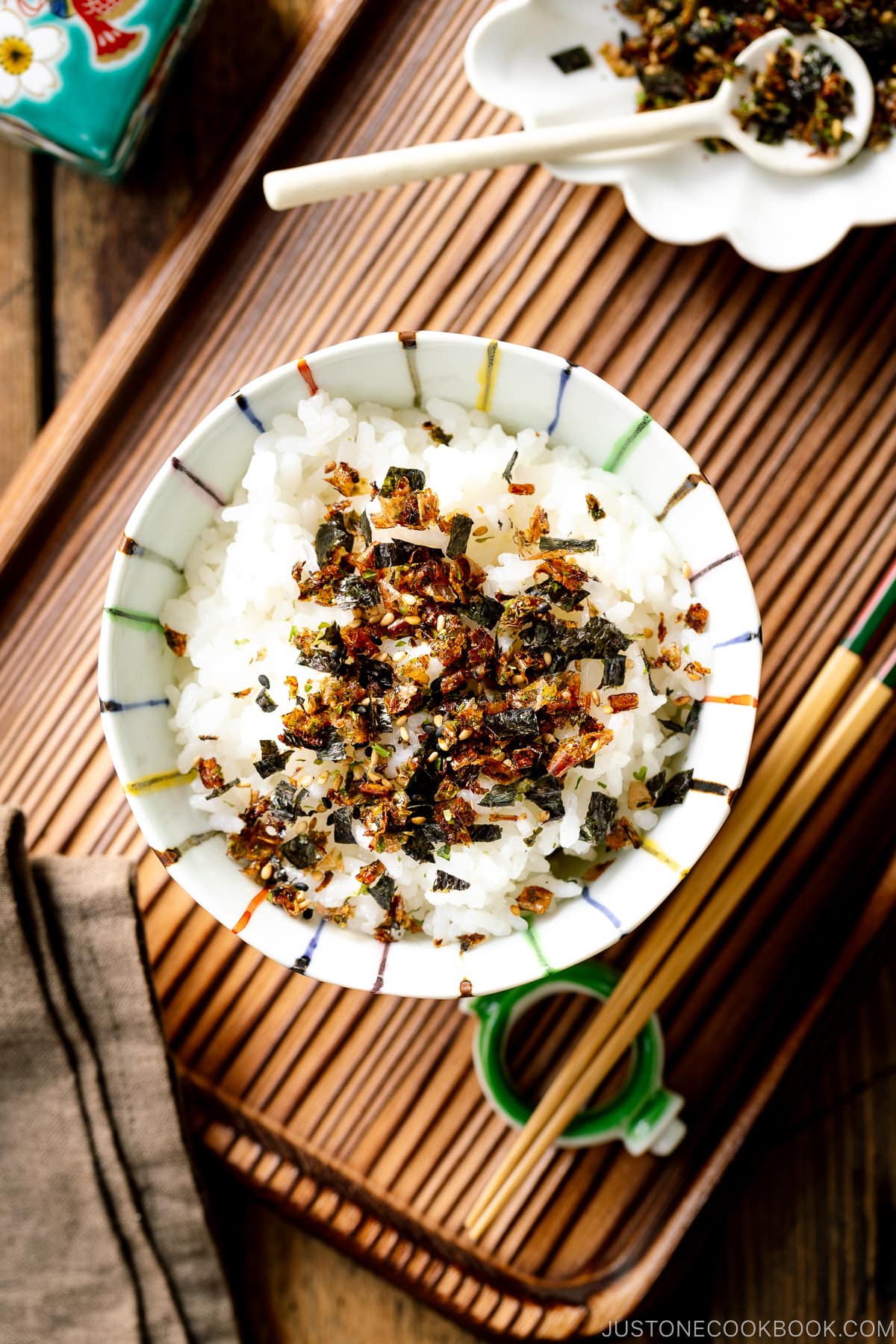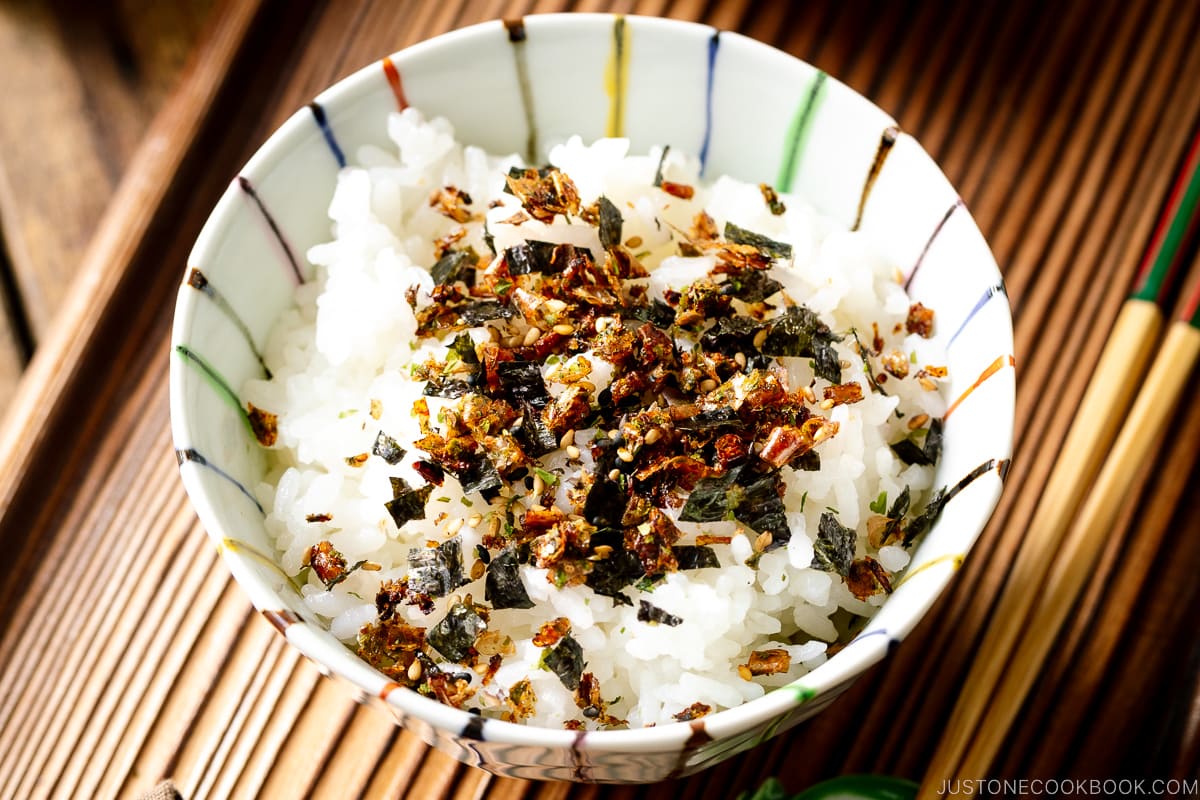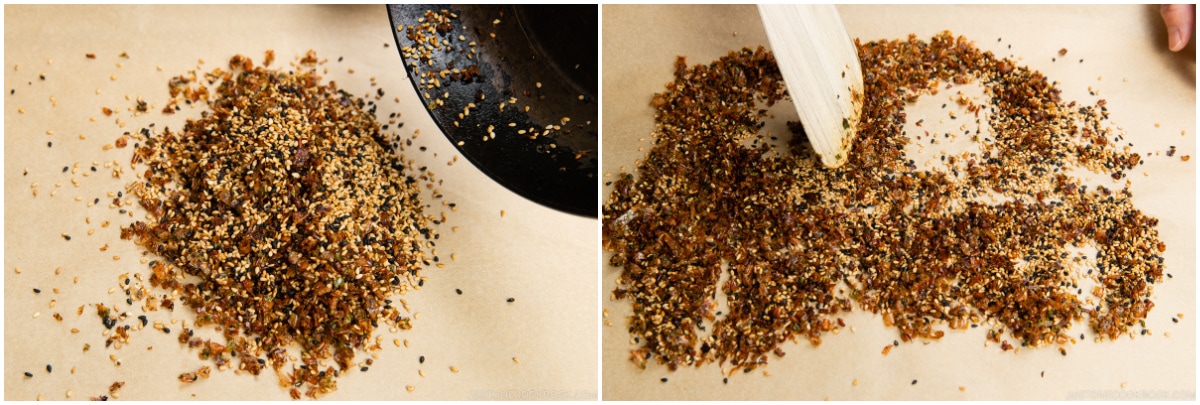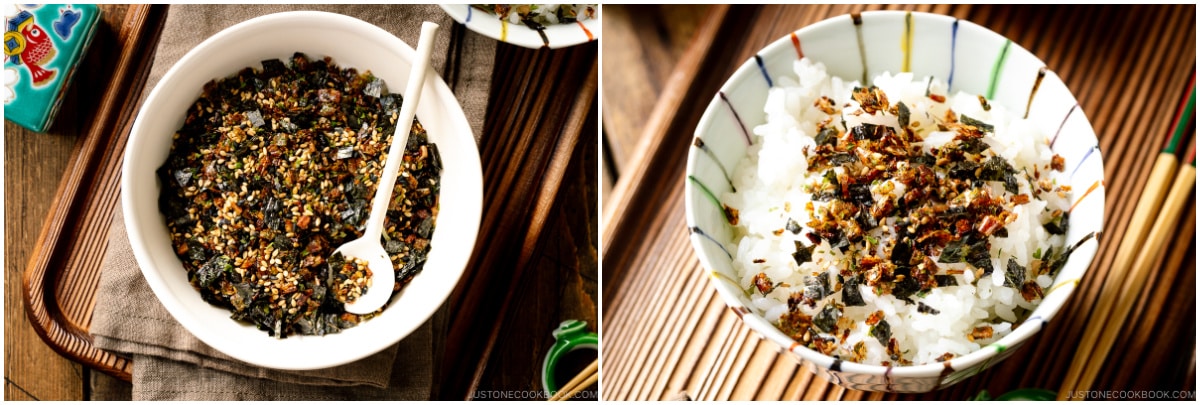Furikake is a savory-sweet rice seasoning with sesame seeds, dried fish flakes, and nori seaweed. This Japanese condiment is fabulous sprinkled on steamed rice, onigiri, udon noodles, salad, and popcorn. My recipe is a great way to repurpose leftover bonito flakes and kombu from making dashi.

Furikake (ふりかけ) is a nutty, crunchy, umami-packed Japanese blend used to season rice. Although it’s referred to as a rice seasoning, furikake is literally the salt and pepper of the Japanese kitchen. It is so versatile that you can use the seasoning to instantly perk up any bland dishes.
Table of Contents

What is Furikake?
Furikake (literally “sprinkle”) is a flaky or powered Japanese seasoning consisting of sesame seeds, seaweed, and dried seafood, meat, or vegetable. You may be familiar with the commercial variety in bottles or individual packets for kids and adults. Even Trader Joe’s has their own version of Nori Komi Furikake Seasoning!
The commercial variety contains a mixture of bonito flakes, toasted sesame seeds, nori seaweed, sugar, and salt. Some include salmon flakes, dried baby shrimp, shiso, egg, wasabi, and vegetables.

Furikake History
It goes back to the 12th century when there are records of making a salty powdered condiment consisting of dried sea bream, salmon, and shark. The current iteration was invented in the early 20th century as a nutritional supplement. It contained ground fish bones and poppy seeds to address the calcium and nutrient deficiency among the population.

How to Make Homemade Furikake
Ingredients You’ll Need
- Katsuobushi (dried bonito flakes) – You can buy it from Japanese/Asian grocery stores or online. This store carries good-quality Hana Katsuo here (ships internationally).
- Aonori (dried green seaweed) – You can buy it online here.
- Roasted sesame seeds – White and black sesame seeds taste differently, so use both!
- Nori (dried seaweed)
- Seasonings: soy sauce, mirin, sugar, salt, and sesame oil
💡 Tip: If you have reserved kombu and katsuobushi from making dashi or mentsuyu noodle soup base, you can repurpose them in this recipe! Read the details below.
Overview: Cooking Steps
This homemade furikake is really easy to make!
- Cook all the ingredients and seasonings in a frying pan until they are dry and separated.
- Let cool completely.
- Add nori seaweed and transfer to an airtight container.

Repurposing Spent Katsuobushi and Kombu
Whenever you make dashi (Japanese soup stock) from scratch, you are always left with spent kombu or katsuobushi, or usually both if you make Awase Dashi (a combination of kombu and katsuo dashi).

The best way to repurpose these spent ingredients is to make homemade furikake.
Another bonus is that you don’t have to use them right away. You can reserve spent kombu and katsuobushi in an airtight container and store it in the refrigerator for a week or in the freezer for up to a month, until you’re ready to make furikake.

Take out the portion you need and cut them into small pieces and cook in the pan with the rest of ingredients.

FAQs
Why do we need to cook the ingredients? Can we just mix everything?
There are two reasons why we cook all the ingredients and season them in a frying pan.
- Dry ingredients absorb all the delicious wet seasonings (soy sauce and mirin), and then become dry. So the ingredients will be flavored.
- If you don’t cook the mixture, loose dry seasonings such as sugar and salt will sink at the bottom of the container and you will end up with a flavorless furikake.
How long does it last?
If you include a Food Safe Silica Gel Desiccant Packet in your airtight container, you can keep the homemade furikake for 1-2 months at room temperature!

Without it, the nori and katsuobushi will start to get stale, so consume the homemade furikake within 2 weeks.

Creative Ways to Enjoy Furikake
Rich in calcium, iodine, and iron, this homemade furikake is a healthy way to season your Japanese dishes!
Furikake is absolutely wonderful on just a simple bowl of rice, porridge, or udon noodles. It’s also perfect for seasoning onigiri (Japanese rice balls), soba noodle salad, grilled salmon, or rice crackers. But don’t stop there, furikake is so versatile that I love to get creative and sprinkle it on these as well:
- Avocado – this is my favorite. Keep it simple and halve the avocado and season it with furikake as an afternoon snack. For a savory breakfast, smear your toasted bread with mashed avocado before you give it a good sprinkle of furikake. It’s a Japanese-twist on avocado toast.
- Egg – you can totally replace salt and pepper with furikake on a fried egg or soft-boiled egg when you want something more punchy.
- Popcorn – planning on binge-watching Japanese shows on Netflix or a Japanese movie night? Flavor your homemade popcorn with furikake to keep to the theme.
- Pasta – oh yes, you can top furikake on Mentaiko Pasta, cacio e pepe pasta, or any simple creamy pasta.
- Furikake Chex Mix – This is one of our family’s holiday edible treats!

A Great Holiday Gift
If you make a big batch, you can even freeze the seasoning for a month. Furikake makes a great holiday gift. Just pack the Japanese seasoning in a cute little glass jar to surprise your foodie friends and family!

Make sure to add a Food Safe Silica Gel Desiccant Packet for each jar, so your friends and family can enjoy it for 1-2 months!

Wish to learn more about Japanese cooking? Sign up for our free newsletter to receive cooking tips & recipe updates! And stay in touch with me on Facebook, Pinterest, YouTube, and Instagram.

Furikake (Japanese Rice Seasoning)
Ingredients
- ⅓ oz katsuobushi (dried bonito flakes) (or 5 2-g packets; you can repurpose ½ oz or 15 g reserved katsuobushi from making dashi or mentsuyu noodle soup base; skip for vegan)
- ½ oz reserved kombu (optional; repurpose reserved kombu from making dashi or mentsuyu)
- 1 Tbsp aonori (dried green laver seaweed)
- 3 Tbsp toasted white sesame seeds
- 1 Tbsp toasted black sesame seeds
For the Seasonings
- 1 tsp sugar (plus more to taste)
- ½ tsp Diamond Crystal kosher salt (plus more to taste)
- 1 tsp mirin
- 1 tsp soy sauce
- ½ tsp toasted sesame oil
For the Add-On Ingredients (after cooling)
- ½–1 sheet nori (dried laver seaweed)
- 1 tsp aonori (dried green laver seaweed) (optional; I added extra aonori for more color)
Instructions
Before We Start…
- It‘s important to cook the ingredients and seasonings together in a frying pan so the ingredients absorb all the seasonings and the furikake is more flavorful. If you don‘t cook it, the sugar and salt simply will sink to the bottom of the furikake jar and the flavors won‘t incorporate well into the furikake.

- In this recipe, you can repurpose the spent katsuobushi and kombu you reserved from making dashi or mentsuyu noodle soup base. Follow the suggested measurements in the ingredient list. To save the spent kombu and katsuobushi for later, you can store in an airtight container in the refrigerator for a week or in the freezer for up to a month.

- Gather all the ingredients.

To Prepare the Spent Katsuobushi and Kombu (if using)
- Gather ½ oz (15 g) spent katsuobushi. Make sure the spent katsuobushi is well drained. Cut it into small pieces with a knife.

- Slice ½ oz reserved kombu (optional) into thin strips, and then cut the strips into small pieces.

To Cook the Furikake
- In an ungreased frying pan, add ⅓ oz katsuobushi (dried bonito flakes) or the reserved katsuobushi, 1 Tbsp aonori (dried green laver seaweed), and the spent kombu (optional). Then, add all the seasonings—1 tsp sugar, ½ tsp Diamond Crystal kosher salt, 1 tsp mirin, 1 tsp soy sauce, and ½ tsp toasted sesame oil. Mix it all together.

- Turn on the stove‘s heat to medium low and cook, stirring constantly, until the katsuobushi becomes dry and flaky.

- Now, lower the heat and add 3 Tbsp toasted white sesame seeds and 1 Tbsp toasted black sesame seeds. Cook, stirring frequently, on low heat until the sesame seeds are nicely roasted and fragrant.

- Transfer the furikake to a baking sheet lined with parchment paper. Spread it out and let it cool completely.

- Once it’s cooled, cut ½–1 sheet nori (dried laver seaweed) into thin strips, and then small pieces ⅛ inch (3 mm) square.

- Add the nori pieces to the cooled furikake and mix everything together.

- Taste the furikake and adjust the seasonings by adding more salt or sugar at this step. I decided to add an additional 1 tsp aonori (dried green laver seaweed) for enhanced color and taste (optional).

- In an airtight glass jar, add one Food Safe Silica Gel Desiccant Packet on the bottom, add the furikake, and close the lid tightly.

To Serve
- Enjoy sprinkling it over steamed rice and popcorn!

To Store
- You can refrigerate it for up to 2 weeks and freeze it for up to a month without a desiccant packet. With the packet, you can keep it at room temperature for 1–2 months.
Nutrition
Editor’s Note: This post was originally published in July 2013. It has been republished on November 27, 2022, with the revised recipe, new images, and updated content with more information.























Hi Nami! How would I made this spicy? Can I add togarashi? Thanks!
Hi Steph! Thank you for reading Nami’s post and trying her recipe!
Sure. You can add Togarashi, chili flakes, wasabi, etc.
https://www.justonecookbook.com/shichimi-togarashi/
https://www.justonecookbook.com/gochugaru-korean-chili-flakes/
https://www.justonecookbook.com/wasabi/
We hope this helps!
I love furikake. Great with eggs, sprinkled on a bagel & cream cheese, anything that needs a flavor bomb & a bit of texture.
I can’t wait to make my own.
Hi Michael, Thank you for reading Nami’s post!
We hope you enjoy the homemade Furikake soon. 😊
What’s the differnce between aonori and nori?
Hi Nat! Thank you for trying Nami’s recipe!
Aonori is a single layer of algae that is very green in color. It has a soft texture that turns powdery when dried. It’s also extremely aromatic.
Nori is a type of edible seaweed made of red algae. Nori has a mildly salty flavor with an umami aftertaste.
https://www.justonecookbook.com/nori/
We hope this was helpful!
Made this today, after making the homemade aware dashi with the homemade udon the day before. So glad to have found a repurpose for the katsuoboshi and kombu! It’s delicious too, just as good as the store bought. I’m delighted and so is my hubby! Along with so many other things its great on plain Gohan! Thank you Nami! So enjoying all your recipes. Takes me “back home” to my Japanese roots
Constance
Hi Constance, Thank you very much for trying many of Nami’s recipe and for your kind feedback! It means so much to us.🥰
We are glad you enjoyed homemade Furikake!
This came out AMAZING! Instructions were easy to follow.
Hi Darcey! Thank you very much for trying Nami’s recipe and for your kind feedback!
We’re so glad to hear that you found Nami’s tutorial helpful.
Happy Cooking!
Just wanted to say I have made this with spent dried shiitake mushrooms instead of spent katsuobushi, because the latter is hard to find and very expensive here…I have yet to try it but it smells very good and quintessentially Japanese. Not that I am a purist, I’ll eat anything if it’s good, but it smells traditional. It is also completely vegan (I’m not) for those who care. I have looked for recipes for specifically vegan furikake (because katsuobushi is expensive) but never found the shiitake version. Now I know it can be done.
It is good. I will be using this recipe as a base. Thanks.
Forgot the rating.
Hi Didina, Thank you very much for trying Nami’s recipe and the five-star rating!🥰
We are so happy to hear you enjoyed the recipe.
Here is the other type of Furikake recipes. We hope you will give it a try one day!
https://www.justonecookbook.com/daikon-leaves-furikake/
https://www.justonecookbook.com/yukari-shiso-rice-seasoning/
https://www.justonecookbook.com/salmon-flakes/
Enjoy!
Are there recipes that use dried mitsuba or shiso? If so, can you please share recipes for those as well? I’m growing my own Japanese herbs but they grow so quickly! I thought it might be a good idea to preserve some. It’d also be a nice homemade gift for friends.
Please keep the good work, I‘m so grateful for all the amazing authentic recipes you share!
Hi Jin! Thank you very much for reading Nami’s post and for your kind feedback!
Currently, Nami does not have a dried Mitsuba or Shiso recipe, but here are recipes that we can recommend.
https://www.justonecookbook.com/yukari-shiso-rice-seasoning/
https://www.justonecookbook.com/shiso-garlic-soy-sauce/
https://www.justonecookbook.com/homemade-shiso-pesto/
We hope this helps!
This is a great recipe.. I had no idea that the left over from the noodle broth could be used for this. I will definitely dry it out in the oven next time as I slightly singed it in a pan… Oishī
Hi Giuseppe! Thank you very much for reading Nami’s post and trying her recipe!
We hope you enjoy homemade Furikake!
Any concern about all the heavy metals like lead that tends to accumulate in seaweed? Seems like it gets higher every year.
Hi Jon, Thank you very much for reading Nami’s post and bring up your concern.
Yes. We concern as it has been changing every year.
Is it absolutely necessary to use sugar or other sweeteners? I am trying to omit such things from my diet, including artificial sweeteners. I am curious if anyone here has attempted it. Thank you!
Hi Vin, Thank you very much for trying Nami’s recipe!
You can make this Furikake without sugar if you would like.
You can also use honey instead of sugar if it works better for you. Please feel free to adjust the amount.
We hope this helps!
Is it possible to add umeboshi to this recipe? I’ve had store-bought furikake with dried umeboshi in it before and it was amazing, I’d love to add it to this! I’m just not sure if I should try to chop it up and dry it out in the oven or in the pan with everything else.
Hi Sierra! Thank you very much for reading Nami’s post!
Yes, you can add dried umeboshi after you cooked this Furikake.
To dry the Umeboshi, you can take out the seeds and flatten/chop the Umeboshi, then bake them in the oven at 250~270F (120~130C) for about 30 minutes.
We hope this helps!
Got some leftover kombu and katsuobushi from making dash, and wanted to try this. But it’s really hard to chop it, it is slimy T_T. Do you have any advice how to make it easier to chop?
Hi Karen, You can try cutting Kombu with Kitchen Scissors.
https://www.amazon.com/dp/B07JQZY7J4?ref=exp_justonecookbook_dp_vv_d
We hope this makes it easier. Thank you for trying Nami’s recipe!
Made this with the left overs of my Dashi! Love how nothing goes to waste and how tasty it is 👌🏼 One could even give it as a present to family and friends.
Hi Maria! Thank you very much for trying this recipe and for your kind feedback.
We are so happy to hear you enjoyed homemade Furikake! Yay!
Could you make this only using kombu? Thanks!
Hi Jonas, Sure. You can do that too.
Nami also has a Kombu Tsukudani recipe that you can try. https://www.justonecookbook.com/simmered-kombu-tsukudani/
We hope this helps!
Great! Thanks for the suggestion!
Need some help troubleshooting – after adding the soy sauce and such, I kept standing there, stirring and stirring this small amount… but it just wasn’t getting “dehydrated and crispy” even after 15 minutes, so I turned up the heat very slightly and then boom, burned. Any suggestions? Maybe it was not well drained enough to begin with even though I tried to press a good amount of liquid out of it? Looking forward to trying again. At any rate, the miso that was originally made with this kombu and katsuobushi turned out fabulously. ^_^
I also have a similar issue and was wondering how to avoid burning on the bottom… eitherways if you do it at low heat, it will stick to the pan but the Furikake still comes out great👌🏼
Hi Severin, Thank you very much for trying many of Nami’s recipes!
To dehydrate used Katusobushi will take some time in a saucepan. You may layout the used Katsuobushi on a baking sheet, air dry them a little bit before making Furikake or warm up the oven, turn off the heat, and then place the layout Katsuobushi in the warm oven may help speed up the drying process. We hope these tips will be helpful.